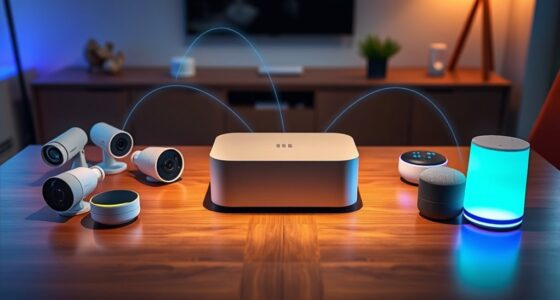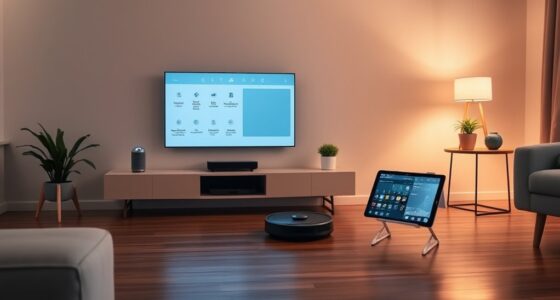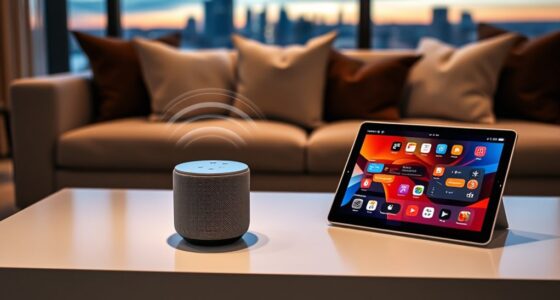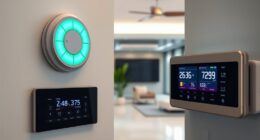To avoid overloading your smart home, limit the number of devices to essential ones that serve clear purposes like security, lighting, or climate control. Too many devices can cause system glitches, compatibility issues, and increase energy bills. Focus on compatible devices that work smoothly together and consider your network capacity. Regular updates and mindful expansion help keep your system reliable and efficient. If you want more tips on balancing your smart home setup, keep exploring these strategies.
Key Takeaways
- Start with essential devices like thermostats, lights, and security cameras to prevent system overload.
- Ensure all devices are compatible and follow common standards such as Zigbee or Z-Wave.
- Avoid adding redundant sensors and gadgets that do not improve safety or efficiency.
- Upgrade your Wi-Fi to a mesh system to handle multiple devices and maintain stable connectivity.
- Regularly review and update your system, removing unused devices to minimize complexity and energy use.
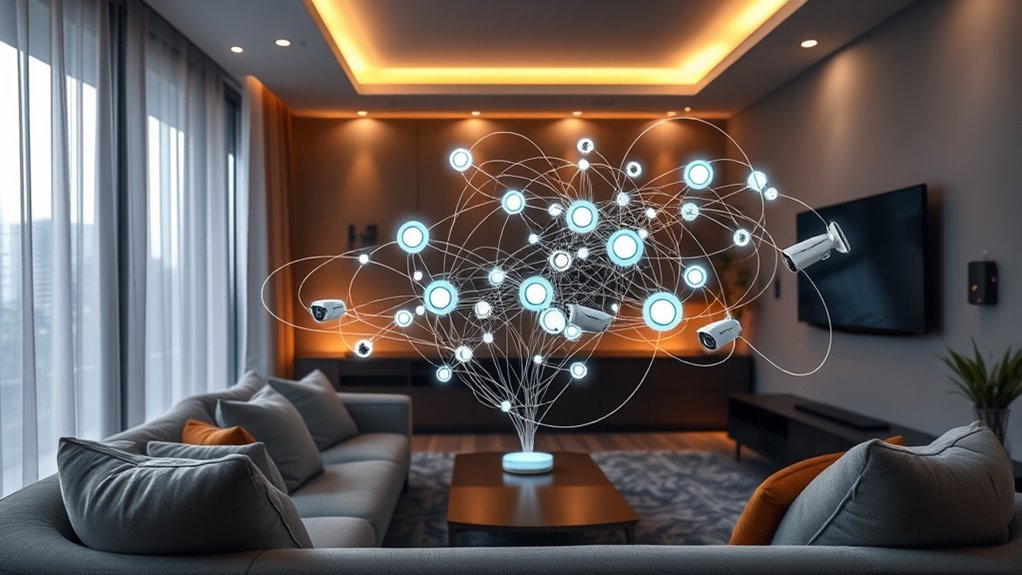
Have you ever wondered how your home can become more efficient and convenient with just a few smart devices? It’s tempting to keep adding gadgets to automate every aspect of your life, but it’s vital to consider how many devices you really need. Overloading your smart home system can lead to problems like increased energy consumption and compatibility issues. When you add more devices, each one consumes power—even when idle—so it’s easy to unintentionally raise your energy bills. To avoid this, you should evaluate whether each device genuinely enhances your daily routine or if it’s just adding clutter.
Adding too many smart devices can increase energy use and cause compatibility issues; choose only what truly enhances your home.
Device compatibility plays a pivotal role in maintaining a smooth, functional smart home. Not all smart devices work seamlessly together; some may require specific hubs or apps, and incompatibility can cause frustration or limit your system’s efficiency. When you’re choosing new gadgets, check their compatibility with your existing setup. Stick to devices that follow common standards like Zigbee or Z-Wave, or those compatible with your preferred voice assistant, such as Alexa, Google Assistant, or Apple HomeKit. This way, you ensure that your devices communicate effectively, reducing the chance of glitches or the need for additional hubs that can complicate your system.
Another important factor is the number of devices you install. While it’s tempting to automate everything, more isn’t always better. Each added device can create potential points of failure and increase your energy consumption. For example, a smart thermostat, smart lights, and security cameras are usually sufficient for most homes. Adding too many sensors, smart appliances, or redundant gadgets can clutter your system and make it harder to manage. It’s better to start with core devices that improve safety, comfort, and energy efficiency, then expand thoughtfully as needed. Additionally, choosing vetted devices can ensure reliability and compatibility, helping you build a more stable smart home ecosystem.
You also need to factor in how your network handles multiple devices. A congested Wi-Fi network can cause delays or disconnections, diminishing your smart home’s performance. Upgrading your router or using a mesh Wi-Fi system can help ensure stable connectivity as you add devices. Remember, it’s not just about quantity but about quality and function. Focus on devices that serve a clear purpose and contribute to your home’s efficiency. Regularly review your setup—removing unused gadgets and updating firmware—to keep energy consumption low and device compatibility high.
Frequently Asked Questions
How Can I Prioritize Which Smart Devices to Install First?
When deciding which smart devices to install first, consider device compatibility and user convenience. Prioritize devices that enhance daily routines, like smart lighting or thermostats, since they offer immediate benefits. Guarantee the devices you choose work well with your existing systems. By focusing on user convenience and compatibility, you create a seamless smart home experience without unnecessary overload, making your setup both functional and enjoyable from the start.
What Are the Signs of Network Congestion Caused by Multiple Devices?
You might notice device overload when your smart home experiences slow Wi-Fi, frequent disconnections, or buffering during streaming. Bandwidth issues become evident if multiple devices stream or download simultaneously, causing lag. You could also see delayed responses from smart gadgets or difficulty connecting new devices. These signs indicate your network struggles to handle the number of devices, highlighting the importance of managing bandwidth and reducing device overload for smooth operation.
Can Too Many Devices Compromise My Home Wi-Fi Security?
Having too many devices on your Wi-Fi network can compromise your home security. When you connect multiple gadgets, it strains your Wi-Fi bandwidth, slowing down your connection and potentially exposing vulnerabilities. Some devices lack proper device encryption, making them easier targets for hackers. To protect yourself, limit connected devices, update firmware regularly, and choose devices with strong encryption. This way, you maintain both ideal performance and security.
How Often Should I Update or Replace My Smart Home Devices?
Think of your smart home devices as fine-tuned instruments; they perform best with regular care. You should consider updating or replacing them roughly every 3-5 years, depending on device lifespan and upgrade frequency. This guarantees they stay secure, efficient, and compatible with new technology. Staying proactive prevents potential security gaps and keeps your smart home running smoothly, so you get the most out of your investment over time.
Are There Specific Brands That Better Support Large Smart Home Setups?
When choosing brands for your smart home, look for those with strong brand compatibility and device interoperability. Brands like Apple, Samsung, and Google tend to offer better integration across their products, making it easier to manage multiple devices seamlessly. You’ll want to avoid brands with limited compatibility, as that can cause frustrations. Prioritize brands known for supporting a wide range of devices and maintaining reliable interoperability to guarantee your smart home runs smoothly.
Conclusion
Think of your smart home as a garden; too many devices are like overgrown weeds choking the space. Keep your setup balanced and manageable, so each device has room to thrive without overwhelming the system. When you limit your gadgets wisely, your smart home becomes a harmonious symphony rather than a chaotic noise. Remember, quality over quantity guarantees your tech garden stays lush, organized, and easy to enjoy. Don’t let overload turn your smart home into a tangled jungle.



